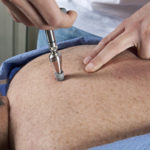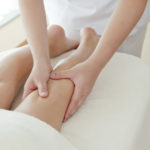Rolfing

What is Rolfing?
Rolfing is a form of deep tissue massage named after Dr. Ida P. Rolf, an American biochemist who referred to her work as “structural integration.” Dr. Rolf designed the system as a way to deeply manipulate and reorganize connective tissue and fascia. Her aim was to relieve patterns of physical misalignment through a series of sessions, each focusing on a different part of the body, using deep pressure and breath work. The ultimate goal along with resetting alignment patterns in the body, is to improve movement and posture, reduce stress and create an overall sense of wellbeing.
What conditions are best treated with Rolfing?
People seek Rolfing as a way to ease pain and chronic stress as well as to improve performance in their professional and daily activities. Because chronic stress often leads to tension in the upper back, neck and shoulders, Rolfing can help the body break these patterns that contribute to chronic discomfort. Athletes may also benefit from Rolfing’s ability to promote muscular efficiency.
Studies have shown that those with neurological impairments such as carpal tunnel syndrome, piriformis syndrome and pronator syndrome can benefit from this structural realignment. Rolfing may be able to relax tissues contributing to jaw pain in a condition known as temporomandibular joint disorder, or TMJD. Asthmatics may also consider Rolfing as a means to break up restrictive patterns in nerves and muscles in the chest that limit full chest expansion. Rolfing can often effectively address structural problems that contribute to low back pain. It can be a beneficial treatment for posture problems, with studies showing effectiveness in the treatment of lordosis or curvature of the spine.
What should one expect on a visit to a practitioner of Rolfing?
A client should wear comfortable clothing that does not restrict movement. Plan to spend at least an hour each session – many practitioners request two hours. The most commonly known system of Rolfing is called the “Ten Series,” which is broken up into three different steps. The first three sessions, typically referred to as “sleeve” sessions, are focused on loosening and rebalancing surface layers of connective tissue. Breathing techniques are suggested to enhance the quality of breath during the session.
Bodywork is typically first done on arms, chest and the abdominal wall, specifically focusing on the diaphragm. It then includes the back and neck as well as moving downward toward the upper legs and buttocks. The second and third sessions finish out the legs and focus on how the body – in context with the head, shoulders and hips – relates to itself in space. The next four, known as the “core” sessions, focus on the body from the head down to the pelvis and the deep tissue of the legs. The last three sessions are termed “integration” as the goal is to achieve balance, movement and coordination within the entire network of the body. Sessions are typically scheduled weekly, but can vary depending on the client and therapeutic goals. Often there is a short discussion following the treatment to determine outcomes and suggest a home program.
Are there any side effects or conditions where Rolfing should be avoided?
Soreness may be a side effect as well as mild pain during treatment. Pain is usually minor, and heat, ice and over-the-counter analgesics may be of short-term benefit. Hydration, before and after treatment, is recommended. It is also of extreme importance to let the practitioner know of any medical conditions you may have. Consult your physician first if you have a connective tissue disorder (such as lupus or scleroderma), are pregnant, or have a psychological disorder. Rolfing may not be recommended in these circumstances.
Extreme caution should be observed for those with cancer. The connective tissue is the protective barrier to the organs beneath it and Rolfing, being deep tissue work, may theoretically affect these tissues leading to a potential advancement of malignant cells. Also, anyone with an embolus or thrombus (blood clots) should not have deep tissue work as it may dislodge the clot. Individuals with high blood pressure, on blood thinners or with a know heart condition should consult with their medical team before undergoing Rolfing, or having any form of deep tissue work. Obviously, those with acute illnesses, infections or injuries should be cleared by a physician prior to having body work performed.
Is there a governing body that oversees or credentials practitioners in Rolfing?
The Rolf Institute of Structural Integration in Boulder, Colorado, is the governing body that certifies Rolfing practitioners in the United States. There are five other international institutes. A course of study up to a year and a half, or 600 to 700 hours (depending on prior certifications and education) is required to become certified in the Rolfing technique. One can then move on to advanced Rolfing, and receive certification in that as well. Trained Rolfers may designate themselves as a CR or CAR (Certified Rolfer or Certified Advanced Rolfer).
How does one get in touch with a practitioner of Rolfing?
The websites www.Rolf.org in the U.S. or www.Rolfing.org in Europe can provide the public with a list of certified practitioners in their respective areas.
Are there other therapies that might work well in conjunction with Rolfing?
When receiving a series of Rolfing sessions, it is generally not recommended to have other bodywork (including chiropractic and massage), so that one knows which specific intervention is actually beneficial. However, breathing exercises, relaxation techniques and energy work can certainly be done in conjunction with Rolfing. The Rolf Institute of Structural Integration promotes Rolfing in conjunction with yoga, Pilates and other low-impact exercises.
What is Dr. Weil’s opinion of Rolfing?
Dr. Weil suggests a thorough medical checkup to make sure that your general health is good and that no undiagnosed problem is responsible for any chronic pain or discomfort. When dealing with posture issues and curvature of the spine, it is important to be sure that the cause is not a serious, underlying medical issue. Once this is addressed and there are found to be no contraindications, then he recommends Rolfing as an effective, low-risk way to address chronic pain.









